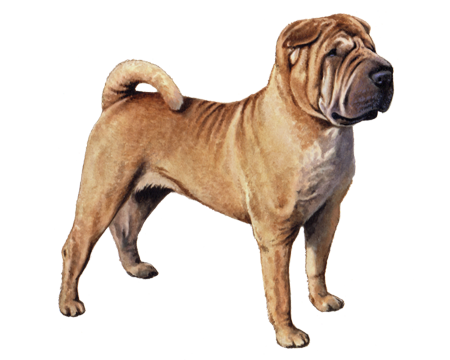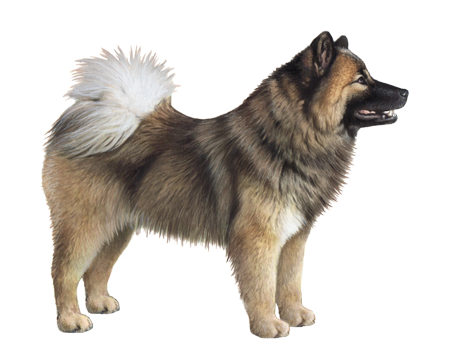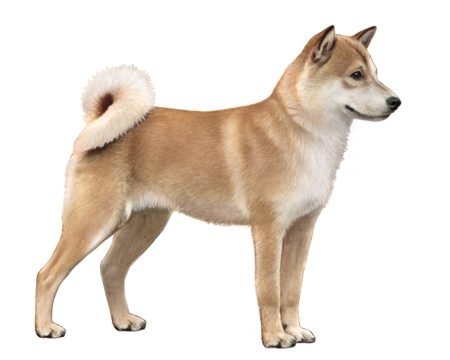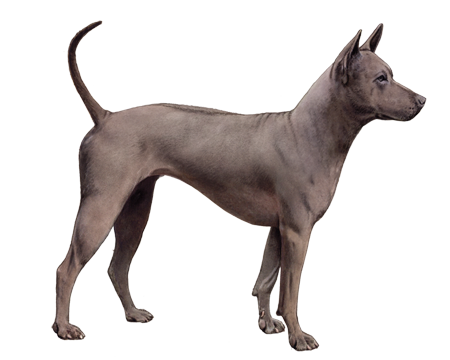
Shiba Inu
This ancient breed got its start as a hunting dog. But the Shiba Inu has since become the most popular companion dog in Japan. Active, attentive, and adaptable, Shiba Inus excel as energetic guard dogs and loyal friends.
Interested in discovering if your dog is a Shiba Inu?
Check out Wisdom Panel's DNA tests.

Shiba Inu Traits
General Appearance
The Shibu Inu is both the oldest and the smallest dog native to Japan. The alert, agile breed has a compact, muscular frame and a confident gaze. These dogs move lightly and gracefully.
Coat and Coloring
A double-coated breed, the Shiba Inu has a soft, thick undercoat and straight, stiff outer coat. Its hair stands up to two inches at the withers, with the tail hair being longer and fanning out in a brush.
Shiba Inus come in three colors: bright orange-red, black with tan points, and sesame. The undercoat is cream, buff, or gray. For show competition, Shiba Inus that are black with tan points must have a brownish cast, and borders between the black and tan areas should be well-defined. Shiba Inus with sesame coloring (a rich red background with black-tipped hairs) should have no significant concentrations of black, and sesame areas must be at least half red.
On all three color patterns, "urajiro" is required for show. This cream-to-white undersurface coloring must be present on the sides of the muzzle, cheeks, underjaw, upper throat, abdomen, insides of the ears and legs, and around the ventral side of the tail.
Distinctive Physical Traits
The Shiba Inu has a broad forehead with a slight furrow, deep-set eyes with outer edges that slant upward, and triangular, pricked ears that tilt forward.
Shiba Inu Temperament
Shibas are independent and reserved with strangers. But with family, the breed is affectionate and loyal. These active, energetic dogs appreciate plenty of activity. And when they get it, they tend to be calm and well-mannered at home.
An adaptable breed, the Shiba Inu, will enjoy hiking in the backwoods as much as walking down crowded urban sidewalks—as long as it's with its people. Shibas can develop separation anxiety if left alone for too long. Shiba Inus have sharp senses, and they're often eager to follow their noses. So, be sure to keep your Shiba on a leash unless there is a secure fence.
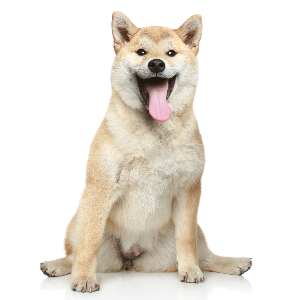
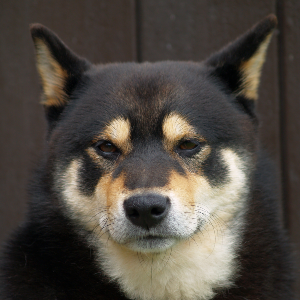
Shiba Inu History
A Japanese breed from 300 B.C., the Shiba Inu served hunters by flushing out birds and tracking game—including wild boar. (In Japanese, "shiba" means brushwood, and "inu" means dog.) But the breed's faithful, affectionate personality earned it a spot as a prized domestic dog.
Though once nearly extinct, Shiba Inus bounced back to become the most popular dog breed in Japan. The 1936 Cultural Properties Act declared the Shiba Inu a precious natural product of Japan. The Shiba Inu came to the United States in the 1950s, where it also quickly gained popularity.
Shiba Inu Care
Nutrition
Some Shiba Inus are indiscriminate eaters. But others can be picky. It might take some experimentation to find a food your dog likes. Look for a high-quality diet that is appropriate for their life stage (e.g., puppy, adult, senior). And consider a food formulated specifically for medium-sized dogs.
It's always wise to monitor how much your pup eats to keep their weight in a healthy range. Measuring out meals can help prevent accidental overfeeding. And don't forget to account for treats. As a general rule, they should make up no more than 10% of a dog's calories.
Grooming
Be prepared to deal with shedding. The Shiba Inu requires regular brushing to remove excess hair. Some owners even use a shop vacuum to remove all the loose hair that seems to fall out in clumps!
Professional grooming is not required (and trimming the coat is prohibited according to the breed standard). But it might be worthwhile to have a pro cut your dog's nails—a necessary task that the breed seems to hate. You should also prioritize regular dental care—including at-home teeth brushing and professional cleanings.
Exercise
Shiba Inus love active games, adventures, and all forms of exercise. Regular walks, swimming, fetch, and hide-and-seek are fun options, as are dog sports—such as agility, flyball, tracking, rally, and competitive obedience.
Training
Consistent training and early socialization will help ensure your Shiba Inu responds to commands and behaves around strangers. For the greatest success, focus on a reward-based approach to training that uses treats or favorite toys to celebrate good behavior.

Shiba Inu Genetic Health Conditions
-
GM1 Gangliosidosis (Discovered in the Shiba)
GM1 gangliosidosis is a disorder of progressive nervous system degeneration, resulting in vision impairment, head tremor, involuntary eye movements, limb weakness with difficulties in balancing and fatigue.
Knowing if your Shiba Inu is a carrier or at-risk for these conditions can help you and your veterinarian plan for your pup’s lifelong care. With Wisdom Panel™ Premium, you can get results for over 200 genetic health tests.
Breed Group
Asian and Oceanian
The Asian and Oceanian group is comprised of breeds whose origins lie in Asia, which have spread as far as Australia, the islands of the Pacific, and the Arctic. This group is possibly the most ancient of all breed groups and were bred for a variety of purposes, including guarding, hunting, and as draft dogs.
Resources
https://www.akc.org/dog-breeds/shiba-inu/
http://images.akc.org/pdf/breeds/standards/ShibaInu.pdf
Reviewed July 26, 2020 by Laura Inman, DVM








